Signs of disease in lily leaves
If the leaves of a lily turn yellow, the cause and treatment depend on the composition of the soil on which the plants are grown, ways of caring for them, and the presence of pests that inhabit the garden. The culture is demanding on the composition of the soil, minerals and reacts to changing weather conditions. A healthy plant has rich green leaves. If yellowness appears on them, then the flower needs help.
Violation of growing conditions
Having carefully examined the landing site, you can understand why do lilies turn yellow leaves:
- excess moisture, as well as its lack, lead to the death of the plant;
- green streaks appear on the yellow leaf - this is chlorosis, this is how the flower reacts to the lack of trace elements in the soil;
- a yellowish and poorly growing crop is a signal of nitrogen deficiency;
- brown leaves indicate excessive watering and excess nitrogen.
It is recommended to water the daylilies sparingly, not allowing the soil around the flowers to dry out.
So that the plant does not suffer from a lack of minerals, it is better to apply them immediately upon planting or in May before flowering. If for some reason this was not done, you can neutralize the effects of chlorosis by adding 3 g of ammonium sulfate or citric acid (lemon juice) to 1 liter of water and spilling a lily. And you can help the plant restore healthy growth and restore brightness to the leaves if you apply nitrogen fertilizers according to the instructions.
Diseases
The yellowed leaves at the bottom of the stem indicate the beginning of gray rot (botrytis) in the lily. The main reason is high humidity. But the first signs of this disease are rapidly growing brown spots. If the plant is not treated, it will not die, but it will stop growing and lose its decorative appearance. It is not harmful to other plants in the garden, unlike botrytis iris.
Important! Soaking the bulbs in a disinfectant solution before planting will prevent this disease. Brown spots on the lily leaves starting from the top are a sign of phytium. It is a fungal disease transmitted with soil and diseased bulbs.
If brown spots appear on the lily buds, this is another manifestation of root rot. The culture sharply slows down its growth, if new leaves grow, then they are small and gradually turn yellow. In the advanced form of the disease, plants die
This is a fungal disease transmitted with soil and diseased bulbs. If brown spots appear on the lily buds, this is another manifestation of root rot. The culture sharply slows down its growth, if new leaves grow, then they are small and gradually turn yellow. In the advanced form of the disease, plants die
Brown spots on lily leaves starting from the top are a sign of phytium. This is a fungal disease transmitted with soil and diseased bulbs. If brown spots appear on the lily buds, this is another manifestation of root rot. The culture sharply slows down its growth, if new leaves grow, then they are small and gradually turn yellow. In the advanced form of the disease, plants die.
Important! If you do not fight the infection, you can lose all planting material. The disease is not dangerous for humans and animals. The disease is not dangerous for humans and animals
The disease is not dangerous for humans and animals.
The defeat of a fungal disease will be the answer to the question of why the leaves of lilies rust. In the initial stage, the disease manifests itself as small whitish spots on the plant. Later, they take on an orange hue, and the leaves dry out. Fungal spores are able to withstand low temperatures and overwinter in the soil along with unharvested leaves.
In the case of the appearance of a color unusual for the variety in flowers, a variegated lily virus can be suspected. The infection is transmitted by insects and through untreated garden tools.
Lily pests
There are about 15 types of pests that affect lilies. These small insects weaken plants and carry viruses. Let's list the most dangerous of them.
Spider mite
This pest feeds on the juice of young shoots, which inhibits the growth of lilies. Red spider mite eggs can live in soil for up to 5 years.
Signs
The lily leaves curl, the plant itself gradually dries up. On closer inspection, the leaves show white eggs and adult red spider mites.
Control measures
If a pest is found, spray the plants with soapy water, insecticides Inta-Ts-M (1 tablet per 10 liters of water), Carbocin or acaricides (Anti-tick, Apollo, etc.).
Squeak beetle (lily beetle, bulbous rattle)
A bright red squeak beetle lays pink larvae on lily leaves, covered with green-brown mucus, which can deprive plants of almost all leaves.
Signs
Larvae and adults of the pest visible to the naked eye.
Control measures
Spray the plants Aliot's solution or another insecticide (Inta-Vir, Fufanon-Nova).
Lily fly
The lily fly starts inside an unpainted lily bud. Damage will become noticeable when the fly larva has already done "its job" and pupated in the ground.
Signs
Eaten pistils and anthers of stamens on flowers.
Control measures
Destroy damaged buds. Spray plants with Aliot's solution or another insecticide (Fufanon-Nova, Spark Double Effect, etc.).
Medvedka
The bear eats the roots, bulbs and stems of the lily.
Signs
The presence of a bear on the site can be seen by the holes in the soil. If you notice that the lily is dying, and numerous passages appear on the surface of the earth around the plant, most likely the reason is precisely in the defeat of the bear.
Control measures
Arrange traps for the bear in the ground. For example, pits with manure or slate shelters where the insect will crawl to warm up and lay eggs. Collected in one place, the bear will be easy to destroy. In late autumn, you need to dig deep into the ground in order to destroy the wintering stages of the pest. The preparations Grizzly (2 g / m2), Medvetox (3 g / m2), Thunder (20-30 g / m2) are introduced into the soil.
Khrushch (beetle larva)
Like the bear, the grub larva eats the underground parts of the flower, which leads to its death.
Signs
White fleshy larvae are visible in the ground. In case of damage, the death of the plant occurs.
Control measures
Dig deep into the soil before planting, manually pick the larvae of the beetle out of it. Chemical preparations are used the same as for the bear.
Onion fly
This pest lays eggs on the soil surface in May-June. Young individuals hatch from the eggs, which are introduced into the bulb, causing it to rot.
Signs
In late spring - early summer, small black flies start circling around the lilies, hovering in flight and making a characteristic babbling sound. If you spot these pests, most likely they have already deposited their larvae in the soil.
Control measures
Spray plants with Aliot's solution or other insecticide (Inta-Vir, etc.). Dig up the ground in autumn, cover with peat. Treat the bulbs with Vitaros before planting.
Clicker beetle (wireworm)
Serious damage to lilies is caused by wireworms - the larvae of click beetles that emit specific sounds resembling clicks. The most dangerous are adult larvae, which can gnaw the bulbs, which entails the death of the entire plant.
Signs
The aboveground part of the plants withers, the leaves curl, and the passages gnawed by the larvae are visible on the bulbs. These bulbs are weakened and quickly rot.
Control measures
The most suitable conditions for a wireworm are moist areas with acidic soil. Therefore, the soil in such places must be limed by adding wood ash or lime. Plants should be watered with a solution of potassium permanganate (3-5 g per 10 l of water). Insecticides are effective against larvae - Provotox, Medvetox, Vallar, Pochin. In the spring, Alatar, Zemlin or Kinmix are used to kill click beetles (in the dosage indicated on the package).
To reduce the number of pests, planting lilies should be kept clean, maintain normal soil moisture, remove plant debris, destroy pests, spray plants with insecticides.
We hope that now, if suddenly your lilies begin to “mope”, you can easily establish the cause of their ill health, clearly identify the pest or disease and “declare war on them” in time. Take good care of your plants and don't get sick.
Diseases of water lilies
Leaf spot
Water lily leaf spot is caused by a fungus that usually thrives in warm and humid weather. Small reddish or brown spots first appear on the leaves, then they grow, spreading to other parts of the plant.
Try to prevent the spread of the disease to all leaves - remove damaged areas in a timely manner
Water lilies should be treated with specialized products, and severely damaged parts should be destroyed. In the same way, you can save the water lily from powdery mildew.
Black root rot
This is the most dangerous disease caused by a fungus. Black rot is manifested by blackening of the roots and an unpleasant odor, the leaves gradually turn yellow.
The smell of rot and yellowing of water lily leaves are sure signs of a dangerous disease.
For the treatment of water lilies, a "bath" with a solution of an anti-fungal agent is used. After treatment, it is necessary to change the water and leave the lilies in quarantine. If within a month the signs of the disease do not show themselves again, the plant can be returned to the pond. If, despite treatment, the symptoms persist, the plant will have to be destroyed.
Diseases of water lilies are much easier to prevent than to cope with later. Take good care of your plants and your pond will be beautiful and healthy.
Bears and wireworms
Bears and wireworms are some of the most common small pests that infest lilies.
Medvedki

If the lily begins to hurt, and numerous small holes are visible on the ground around it, then the reason most likely lies in the defeat of the roots of the bulb and stem by bears.
For control of these insects on traps are arranged on the site. For this, small holes are dug in the ground and filled with manure. Bears crawl into them to lay eggs and warm themselves. And since they are gathered in one place, it becomes much easier to destroy them.
To destroy wintering pupae in late autumn, the earth is well dug up and the preparations "Thunder", "Medvetox" or "Grizzly" are introduced into it in accordance with the instructions.
Wireworms
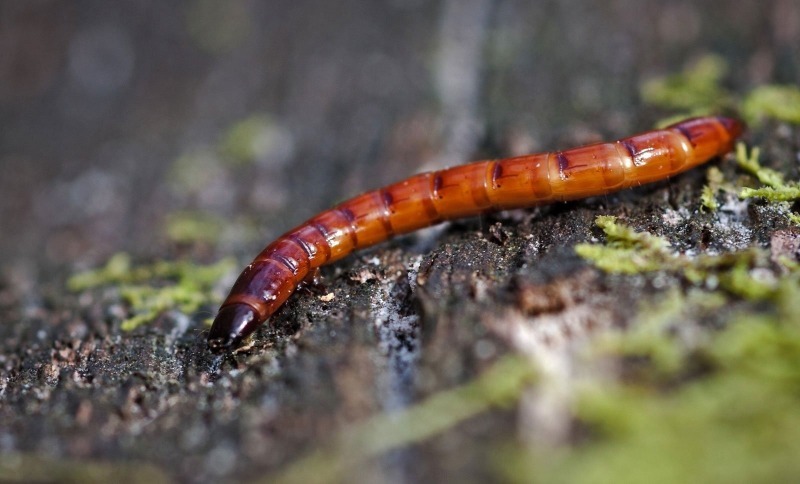
The larvae of click beetles - wireworms - cause great harm to the plantings of lilies. They feed on flower bulbs, gnawing numerous passages in them. Affected plant leaves and flowers wither. When viewed on the bulbs, it is easy to see the numerous holes.
Wireworms are very fond of acidic and moist soil. Therefore, to combat them, the soil must be alkalized by adding lime or ash to it. To protect the lilies, it is recommended to water them with a pale pink solution of potassium permanganate (potassium permanganate).
Kinmix, Zemlin or Alatar are used to kill adult click beetles, and Pochin, Vallar, Medvetox, Provotox are very helpful in the fight against larvae. They should be used in dosages that are indicated on the package.
Common diseases
Finding out the exact cause can be difficult, as an unhealthy appearance can be the result of several diseases. But any disease is much easier to prevent than to eliminate.
Root collar rot
One of the most common diseases is root collar rot. Infection occurs with the help of pests or due to poor air circulation in the soil. Overly buried planting and freezing of the roots can also become the cause of the disease. Quite often, the disease manifests itself with the help of yellowed leaves.
For treatment, it is required to reduce the amount of nitrogen fertilizers, prevent water retention during watering and slightly dry the root of the daylily before planting it in the ground.
Sometimes the disease is not limited to yellowing of the leaves, but takes on a more severe form, expressed by the appearance of decaying roots, a softened stem in the lower part of the plant. In this case, the daylily should be dug up immediately. After that, it is required to remove the damaged areas and treat the cut sites with a disinfectant. For this, a strong solution of potassium permanganate is suitable, in which the root and the diseased part of the stem are placed for 20 minutes. After disinfection, the culture is carefully dried in the shade in the open air. This should be done for 2-3 days, until the sore spots dry out and become hard.
Striped leaves - streak
Striped leaves are classified as fungal diseases. At the same time, yellow strokes appear in the center of the leaves, which subsequently acquire a reddish-brown color. In this case, the plant does not die, but the diseased leaves fall off. Insects can also be the source of the disease, this can also be the result of unfavorable weather conditions or the consequence of a violation of the rules for caring for the plant.
Sometimes treatment is carried out by treating the plant with fungicidal preparations with the concomitant removal of the affected leaf plates.
Rust
Fungal diseases also include the appearance of so-called rust on the buds and leaves. It looks like yellow-orange pustules. The daylily does not die, but its growth slows down and it stops blooming.
Fungal spores are transmitted by air. They take root very well on valerian plants. For this reason, they should not be planted near daylilies.
Chlorosis
Chlorosis is manifested by a change in the color of the foliage. Instead of a healthy green color, it takes on a pale yellow color. The reason for these changes is the lack of chlorophyll. Yellowing can be focal and ubiquitous, all over the leaf blade. The plant can completely die from this. Chlorosis should not be confused with the natural yellowing of old leaves.
The cause of the disease can be soil oversaturated with lime with a lack of iron content with a certain alkaline reaction that impedes the movement of mineral salts. Also, the daylily can get chlorosis due to a violation of the nutrition of the root system, excess or lack of moisture, hypothermia of the soil, toxicity of substances (herbicides), insects.
Chlorosis can also occur with infection. In this case, the spots on the leaves are colorless. As experienced flower growers say, such a disease also develops when roots are injured during transplantation, when the dates for digging a crop are not observed, and when planting in heavy, water-saturated soil, especially when it is pre-fertilized with manure.
To combat the disease, you need to understand its source. Perhaps getting rid of the problem by slightly acidifying the soil or enriching it with iron preparations. Removing excess moisture and killing insect pests can also help.
Spraying the plant with Ferovit, which contains nitrogen and iron chelate, helps with chlorosis.
Pest insects - who are they and how to get rid of?
Not only fungal and viral diseases can interfere with the life of a plant, but also pests, which, as a rule, are the main pathogens of infection. In order to protect your plant from pests as much as possible, experienced gardeners recommend annually in the spring to water the garden plot where lilies grow with the following solution. Take 1 tbsp. l. ammonia, soda and copper sulfate and dilute the mixture in 9 liters of water. With this solution, not only spill the soil, but also spray the lilies. This should be done when sprouts appear (in spring).
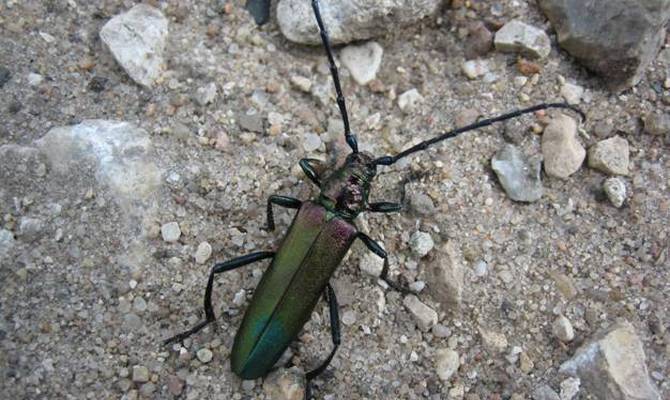
Squeak beetle
The first one who would like to highlight among pests is a squeak beetle or a lily beetle. Outwardly, it is very similar to a firefighter beetle, with a bright red color, as in the photo, and in its appetite - to the Colorado potato beetle. Feeding on the leaves, bulbs and flowers of the plant, it leaves numerous holes, covering the damaged sites with green-brown mucus. The larvae are pink in color, hidden under a dense layer of excrement, so they are sometimes difficult to detect. Fighting adult beetles is quite simple, but when larvae appear in these individuals, the task becomes much more difficult. Among insecticides, a 0.2% solution of Karbofos, Intavir or Decis can be advised.
Lily flies are another common pest of lilies. Most often, these insects settle inside an unpainted bud, mercilessly eating the pistils and anthers of the flower. Treatment with insecticides Ditox, EC, Karbofos helps to fight pests. Similar pests that eat the plant's bulbs are onion hover flies. These black beetles are especially active in May-June, laying eggs on the surface of the soil. By eating the bulbs from the inside, they contribute to their decay and death. In order to combat pests, insecticides such as Karbofos, Intavir are used, in the fall they carefully dig up the soil and mulch it with peat, and before planting the bulbs they dust them with Bazudin.
Known pests of the entire garden, including lilies, are spider mites. Their main purpose is the juice of young shoots, as a result of which the plant stops growing, the leaves curl and gradually dry out. A characteristic sign of the presence of a pest is the formation of white plaque and clutches of eggs, as well as entangling cobwebs. The fight against these garden mites is carried out using a soap solution, a chemical preparation Karbofos, Aktofit or Apollo.
Bears are large enough in size and scale of damage. They feed on all parts of the plant, in particular in lilies, they are most attracted to bulbs, roots and stems. You can notice the presence of bears by the numerous passages that they leave behind in the soil. They destroy pests with baits, digging holes with manure or constructing slate shelters. Bears easily fall into such traps in order to warm up and lay the next clutch of eggs. So they can be easily destroyed, and in late autumn, carefully dig up the ground in order to get rid of the wintering of these pests in the ground.
Prevention measures
To prevent the development of such undesirable phenomena, it is very important to observe all preventive measures. They will reduce the likelihood that the flower can dry out and crumble without starting to open.
The main preventive measures are reduced to three components:
- compliance with all agrotechnical rules for growing lilies;
- crop rotation of flowering plants.
- regular inspection and irrigation of plants with fungicides, insecticides or decoctions prepared according to folk recipes.
Many flower lovers start to panic and do not know what to do. This problem is quite common, so it will not be difficult to solve it. It is enough to reconsider your approach to care and, if necessary, use chemicals.
While breaking up the garden and filling it with different flowers, do not forget that each of them requires care.Moreover, different varieties of flowers require an individual approach. Poor plant health can be influenced by many factors. Today, a fairly common problem is lily buds falling off. What is the reason for this and what do professional gardeners advise to do?
Reasons for falling buds in lilies:
1. Perhaps the reason for the fall of the bud lies in improper care, or rather watering. If the plant does not receive the proper volume of liquid, then it may begin to deform. Very often, when the heat is on the street, moisturizing themselves, many completely forget about the plants. But they also need watering. Lily is the flower that requires attention, and if it does not receive the proper amount of water, it simply begins to fade. To avoid such a reaction, during the budding period and until it opens, the soil must be moistened. It is best to water the lawn in the evening.
2. An infectious or fungal disease of the plant can also cause the loss of a bud. Some diseases can not only significantly spoil the appearance, but also affect the loss of some parts of the plant. In addition, yellow or brown blotches can be observed on the leaves and petals. In order to prevent the further spread of the disease, it is necessary to remove the dying parts of the flower, and if there are symptoms and they are determined at the initial stage, it must be sprayed with a special solution. In order to prepare it, you need to take about 300 g of ferrous sulfate for one bucket of water. Instead of the latter, you can use from 35 to 65 g of copper oxychloride and dilute it in 10 liters of liquid.
3. Sometimes there is a sharp darkening and subsequent dropping of the bud. Spotting or gray rot is responsible for this. It is formed after prolonged rains. The primary symptoms are dark spots covering the entire surface of the plant, which subsequently begin to rot. A yellow border appears around them. In this case, the flower is strongly deformed, rots and then the bud falls off. If the decay process was noticed at the initial stage, then you can prevent its spread by treating it with a fungicide or Bordeaux mixture.
4. Pests can cause the bud to fall off. The peak of attacks on lilies occurs at the beginning of summer, at which time lily flies attack the plant. At the same time, they lay eggs in flowers, subsequently from which larvae will appear, which love to eat stamens and petals. After a while, the flower begins to roll up and subsequently falls off.
5. Finally, the stem nematode is worth noting. These are small worms for which the lily is food. During feeding, they inject a digestive enzyme into the flower, from which it weakens. No less dangerous for lilies are the lily rattler and the fire beetle, from their actions the bud also quickly falls off.
Ekaterina Tolipenko
Lilies are beautiful flowers with amazing aroma and beauty. They are successfully grown both in suburban areas and in residential buildings and apartments. With proper care and adherence to certain measures, the plant will delight the owner throughout the year.
However, quite often novice gardeners ask themselves: why lilies do not bloom? This can happen for many reasons, but most often the flowering process is absent due to improper care of delicate plants. Therefore, before starting to grow these flowers, it is worth learning more about them.
Rodents
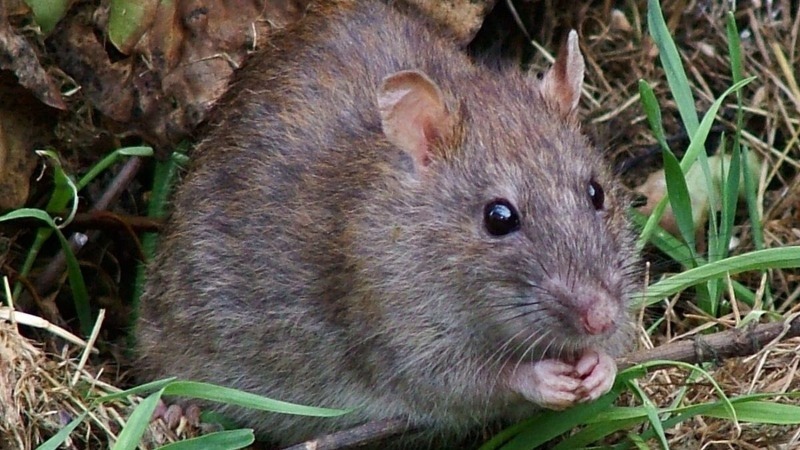
Various rodents love to feast on juicy bulbs of lilies, especially in winter. Various methods are used to protect against them:
- planting bulbs in purchased or made from scrap materials (plastic bottles, plastic boxes) containers;
- burying branches of roses, rose hips or blackthorns next to the flower bed;
- unfolding burdock fruits in the place of planting of lilies;
- installation of mousetraps;
- ultrasonic scarers.
Many gardeners recommend treating lily bulbs with various substances with a pungent unpleasant odor before planting. For this purpose, kerasin and Vishnevsky's ointment are excellent.
How to deal with the main pests of lilies
Many growers are faced with pests when growing lilies. Great harm is done by larvae of beetles, potato scoops, onion beetles, etc. Different methods are used to combat pests, but the most popular are: soaking the bulbs before planting in insecticides or potassium permanganate, prevention during flowering, timely elimination of weeds, dried flowers and leaves.
Lily fly
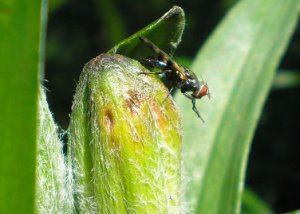
The lily fly is clearly visible on the lily due to its red color. She lays eggs from April to September. The fly and its larvae feed on the leaves, flowers and seed boxes of lilies, which causes great harm to the plant. To combat lily fly, synthetic pyrethroids (Fastek, Karate, Decis, Antizhuk) are used. The treatment will need to be repeated after two weeks.
Potato scoop
The potato scoop is very dangerous for lilies. The caterpillar is red in color and its eggs are found on wild weeds and grasses. It can travel on weed lilies that grow nearby. The caterpillar eats young shoots from the inside, the flower breaks off and withers. You can fight it by the timely elimination of weeds.
Onion mite
The mite, which is only 1 mm in size, causes irreparable damage to the lily bulbs. It eats the scales of the bulb, causing it to rot. The lily leaves turn yellow and die, it stops growing. Gradually, the mite spreads to other bulbs through the soil, and thus all bulbous plants become infected. You can fight the pest by digging up and destroying the infected bulbs. For prophylaxis, before planting, the bulbs should be kept in a solution of potassium permanganate or "Karbofos", sprinkled with chalk.
Important!
If your garden area has been infested with a mite, do not grow bulbs for 3-4 years until it disappears completely.
Aphids and spider mites

Aphids are a very small but dangerous pest. Aphids on lilies greatly weaken the plant, eating it and infecting it with viral infections. You can get rid of it by spraying the lily with insecticides. Spider mites drink juice from plants, from which the leaves begin to turn yellow, become covered with a cobweb and dry out. Lily mites can be infected by mites from fruit trees or berry bushes that grow nearby. For the prevention and control of the pest, it is necessary to spray not only lilies, but also nearby shrubs and trees.
Squeak beetle
The most dangerous enemy of lilies is the squeak beetle. But most dangerous of all are its larvae. They are distinguished by their great gluttony. The beetle and its larvae eat the leaves of the lilies and carry various viruses. The squeak beetle is resistant to various chemicals, so it is best to kill it by hand. Be careful: if you drop the beetle, it will pretend to be dead, turning over on its back, and since the color of its abdomen is black, it is difficult to find it on the ground.
Processing lilies in the spring from diseases and pests
Unfortunately, lilies often get sick, they are damaged by many pests. Experienced gardeners know that the best way to fight is prevention and timely assistance. After all, the sooner a disease is discovered, the easier it will be to treat it, and the more chances you have to preserve the entire blooming collection. That is why it is strongly recommended to spill emerging seedlings with special solutions. For example, a mixture of soda, ammonia and copper sulfate or Bordeaux liquid and copper oxychloride.

Figure 11. Lilies infested with aphid colonies
In addition, immediately before planting, it is advisable to treat the bulbs with a 0.2% solution of foundationol or a solution of karbofos (1 tablespoon per bucket of water). You can also disinfect the bulbs in a weak solution of potassium permanganate.
Advice from Lyudmila .. Fundazol-poison .. very carefully with it, we use it only in extreme cases ..
Fungal diseases of lilies
Lily is attacked by fungal infections found in many flower crops. The spread of rot is facilitated by high humidity, improper care, and lack of preventive measures.
Of all fungal diseases, gray rot is the most dangerous. Initially, the disease affects the lower leaves of plants, but very quickly spreads to all parts of the flower.
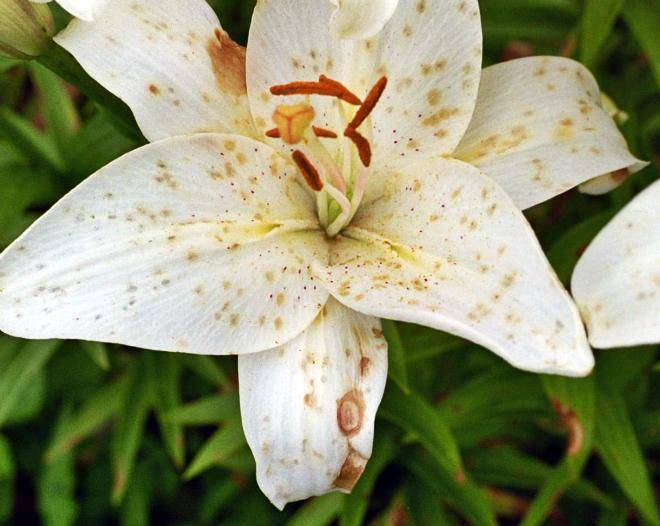
Signs
The first signs of gray rot are brown round spots, which in the process of development are transformed into brown mucous tissue with a gray coating. Gray rot spreads in rainy and damp weather, as well as during sudden changes in temperature. Affected lilies do not die, but only slow down in growth and lose their decorative effect.
Control measures
It is difficult to stop the disease, since the pathogen hibernates in bulbs and plant debris. Therefore, before planting, the bulbs must be soaked in a 0.5-1% solution of a TMTD dressing agent or in a 0.25-0.5% Fundazole suspension. When the first signs of the disease appear, the flowers are treated every 1-1.5 weeks with a 1% solution of Bordeaux liquid or another fungicide (Fundazol, Hom, Oxyhom).
Fusarium
Fusarium is a rot that affects the bottom of a lily bulb. A plant that normally develops during the growing season dies during wintering. The cause of the disease is dampness, the introduction of organic fertilizers containing spores of the fungus.

Signs
Fungus damage begins at the bottom of the bulb. Where scales attach to it, the lily bulb turns brown and falls apart. It is almost impossible to recognize this disease on a growing flower, since it can develop normally due to the supra-luminal roots that are not damaged by the fungus. Nevertheless, in winter, the plant is doomed to inevitable death.
Control measures
Disinfect the soil with copper sulfate and formalin 2-3 weeks before planting the bulbs. Soak the bulbs themselves for half an hour in a 0.2% solution of Fundazole. Spray plantings every 1-1.5 weeks with a 0.1% solution of Fundazol or Bavistin. You can also carry out treatments with 0.2% Topsin-M or Euparen solution.
Phithium is a disease of lilies, which causes rotting of the roots, as a result of which the development of culture is disrupted: the plant does not receive enough nutrients and moisture. Affected lily loses its decorative effect, blooms poorly.
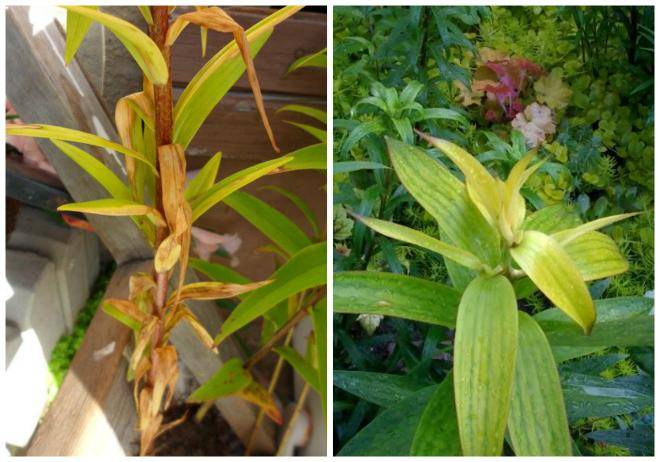
Signs
The tops of the leaves turn yellow, the lily dries. The roots of the bulb are covered with brown spots.
Control measures
Remove the affected parts of the plant. Before planting, infect the soil with a 0.4% solution of colloidal sulfur, soak the bulbs for half an hour in a 0.2% Fundazole solution.
Blue mold attacks the bulbs during storage.
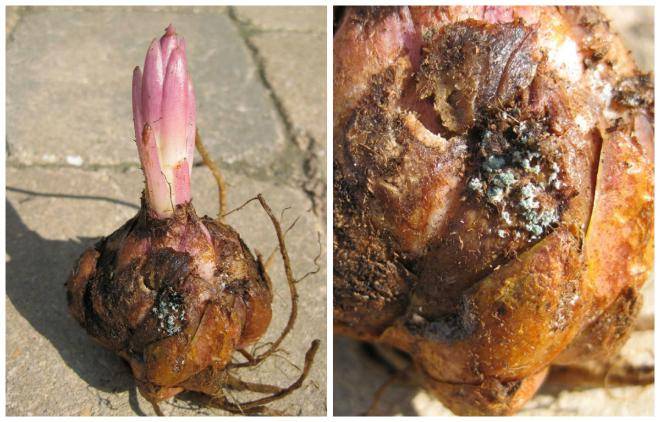
Signs
White spots of fungal hyphae with a greenish bloom on the bulbs. When you dig up the bulbs, you will notice that they have turned yellow and their roots are dead.
Control measures
Rejection of diseased bulbs. Compliance with storage rules. Ventilation and disinfection of the store.
Penicillosis
Penicillosis affects all parts of the lilies and provokes their decay.
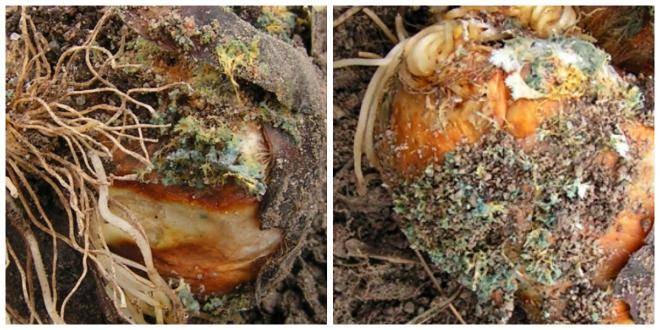
Signs
Bulbs, flowers, stems are covered with a green bloom. Sick plants are stunted and form weak peduncles.
Control measures
Observe storage rules. When the first signs appear, pickle the affected bulbs in a 0.2% solution of potassium permanganate.
Rust
This disease is transmitted through plant debris contaminated with fungal spores.
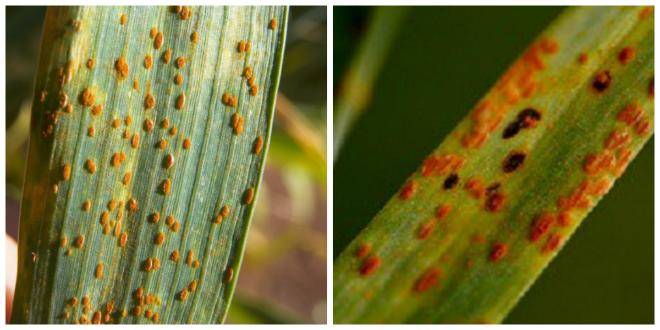
Signs
The first signs of the disease are small colorless spots that turn yellow over time. Pads of red spores appear on the surface of the spots. As a result, the stems and leaves of the lilies dry out.
Control measures
Remove and burn affected leaves. Spray the plants with a 0.2% solution of Tsineb and regularly feed them with potassium-phosphorus fertilizers. Re-plant lilies in the area where the bulbs affected by rust grew, no earlier than after 3 years.
Lily viral diseases
Bulbous viral diseases are spread by pests (aphids and thrips) or by the growers themselves through infected garden tools.
Cucumber and tobacco mosaic viruses
A fairly common disease of lilies, which is carried by aphids.
Signs
Cucumber and tobacco mosaic viruses appear as light streaks and ring spots on leaves and flowers. As a result of the defeat, the lily stem is deformed, stops growing.
Control measures
Regularly inspect lilies and remove suspicious leaves, destroy specimens affected by mosaics. Disinfect garden tools. In order to control the vector of the disease (aphids), spray the plantings with Aliot's solution (10 ml per 10 liters of water).
Tulip variegation virus
This virus takes up residence inside the cells of lilies. Most often, aphids are transferred from tulips.
Signs
The variegation virus disrupts the pigmentation of the petals, as a result of which flowers appear with strokes, strokes, spots of a different color. Diseased bulbs of the next generation decrease in size, the plants weaken, the variety gradually degenerates.
Control measures
Spray plantings with a solution of Inta-Ts-M (1 tablet per 10 liters of water) to protect them from aphids. Regularly inspect lilies and remove suspicious leaves, destroy specimens affected by mosaics. Disinfect garden tools.
Rosette disease
The onset of this disease in lilies is provoked by a whole complex of viruses.
Signs
Lilies infected with this virus are characterized by thickening and yellowing of the stem and the absence of flowers.
Control measures
Spray planting Inta-Ts-M (1 tablet per 10 liters of water) to protect them from aphids. Regularly inspect lilies and remove suspicious leaves, destroy specimens affected by mosaics. Disinfect garden tools before any manipulations with bulbs and aboveground parts of plants.


